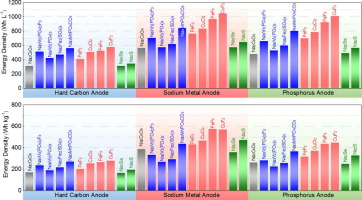当前位置:
X-MOL 学术
›
Mater. Today
›
论文详情
Our official English website, www.x-mol.net, welcomes your
feedback! (Note: you will need to create a separate account there.)
Multi-electron reaction materials for sodium-based batteries
Materials Today ( IF 21.1 ) Pub Date : 2018-11-01 , DOI: 10.1016/j.mattod.2018.03.004 Feixiang Wu , Chenglong Zhao , Shuangqiang Chen , Yaxiang Lu , Yanglong Hou , Yong-Sheng Hu , Joachim Maier , Yan Yu
Materials Today ( IF 21.1 ) Pub Date : 2018-11-01 , DOI: 10.1016/j.mattod.2018.03.004 Feixiang Wu , Chenglong Zhao , Shuangqiang Chen , Yaxiang Lu , Yanglong Hou , Yong-Sheng Hu , Joachim Maier , Yan Yu

|
Abstract Sodium-based rechargeable batteries are very promising energy storage and conversion systems owing to their wide availability and the low cost of Na resources, which is beneficial to large-scale electric energy storage applications in future. In the context of attempting to achieve high-energy densities and low cost, multi-electron reaction materials for both cathodes and anodes are attracting significant attention due to high specific capacities involved. Here, we present a brief review on recently reported multi-electron reaction materials for sodium-based batteries. We mostly concentrate on true multi-electron reactions that involve individually valence changes greater than one per redox center, but in addition include materials in the discussion, which undergo multi-electron processes per formula unit. The theoretical gravimetric and volumetric (expanded state) capacities are studied for a broad range of examples. Then, the practically achievable volumetric energy density and specific energy of Na cells with hard carbon, sodium (Na), and phosphorus (P) anodes are compared. For this purpose, various data are recalculated and referred to the same basis cell. The results show the potential superiority of the cells using multi-electron reaction materials and provide an intuitive understanding of the practically achievable energy densities in future Na-based rechargeable batteries. However, these multi-electron reaction materials are facing several key challenges, which are preventing their high-performance in current cells. In order to overcome them, general strategies from particle design to electrolyte modification are reviewed and several examples in both cathode and anode materials using such strategies are studied. Finally, future trends and perspectives for achieving promising Na-based batteries with better performance are discussed.
中文翻译:

钠基电池用多电子反应材料
摘要 钠基可充电电池具有广泛的可用性和低成本的钠资源,是非常有前景的能量存储和转换系统,有利于未来大规模的电能存储应用。在试图实现高能量密度和低成本的背景下,用于正极和负极的多电子反应材料由于涉及高比容量而引起了极大的关注。在这里,我们简要回顾了最近报道的用于钠基电池的多电子反应材料。我们主要关注真正的多电子反应,这些反应涉及每个氧化还原中心的单个价态变化大于一个,但此外还包括讨论中的材料,这些材料在每个分子式单元中经历多电子过程。理论重量和体积(膨胀状态)容量被研究为广泛的例子。然后,比较了具有硬碳、钠 (Na) 和磷 (P) 阳极的钠电池实际可实现的体积能量密度和比能量。为此,将重新计算各种数据并参考相同的基础单元格。结果显示了使用多电子反应材料的电池的潜在优势,并提供了对未来钠基可充电电池实际可实现的能量密度的直观理解。然而,这些多电子反应材料正面临几个关键挑战,阻碍了它们在当前电池中的高性能。为了克服它们,回顾了从颗粒设计到电解质改性的一般策略,并研究了使用此类策略的正极和负极材料中的几个例子。最后,讨论了实现具有更好性能的有前景的钠基电池的未来趋势和前景。
更新日期:2018-11-01
中文翻译:

钠基电池用多电子反应材料
摘要 钠基可充电电池具有广泛的可用性和低成本的钠资源,是非常有前景的能量存储和转换系统,有利于未来大规模的电能存储应用。在试图实现高能量密度和低成本的背景下,用于正极和负极的多电子反应材料由于涉及高比容量而引起了极大的关注。在这里,我们简要回顾了最近报道的用于钠基电池的多电子反应材料。我们主要关注真正的多电子反应,这些反应涉及每个氧化还原中心的单个价态变化大于一个,但此外还包括讨论中的材料,这些材料在每个分子式单元中经历多电子过程。理论重量和体积(膨胀状态)容量被研究为广泛的例子。然后,比较了具有硬碳、钠 (Na) 和磷 (P) 阳极的钠电池实际可实现的体积能量密度和比能量。为此,将重新计算各种数据并参考相同的基础单元格。结果显示了使用多电子反应材料的电池的潜在优势,并提供了对未来钠基可充电电池实际可实现的能量密度的直观理解。然而,这些多电子反应材料正面临几个关键挑战,阻碍了它们在当前电池中的高性能。为了克服它们,回顾了从颗粒设计到电解质改性的一般策略,并研究了使用此类策略的正极和负极材料中的几个例子。最后,讨论了实现具有更好性能的有前景的钠基电池的未来趋势和前景。











































 京公网安备 11010802027423号
京公网安备 11010802027423号